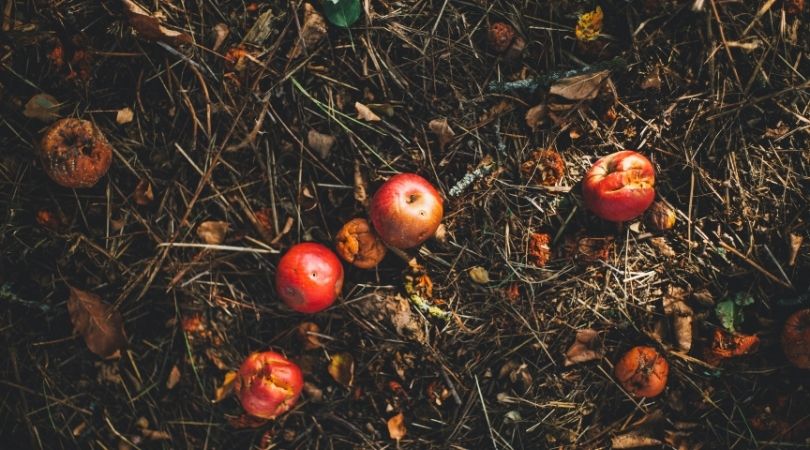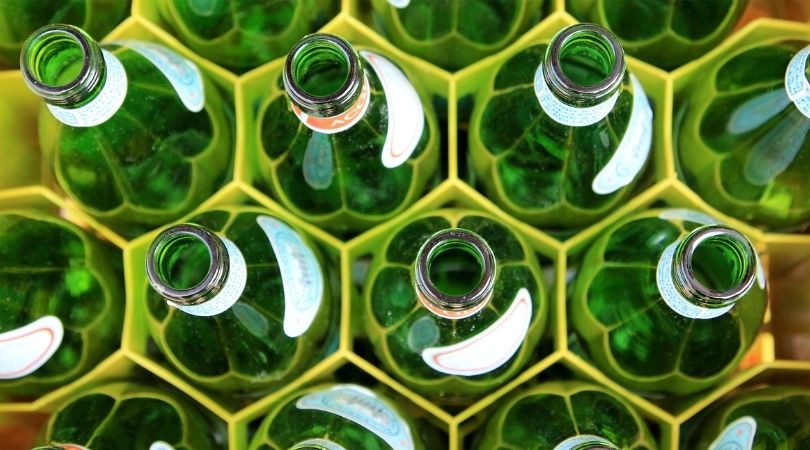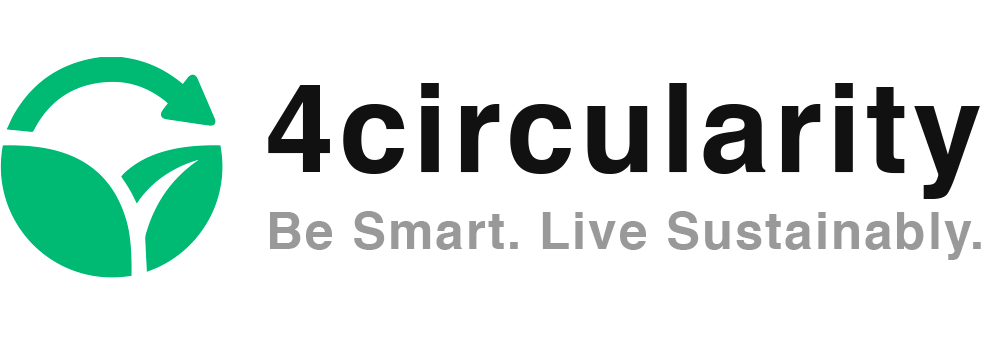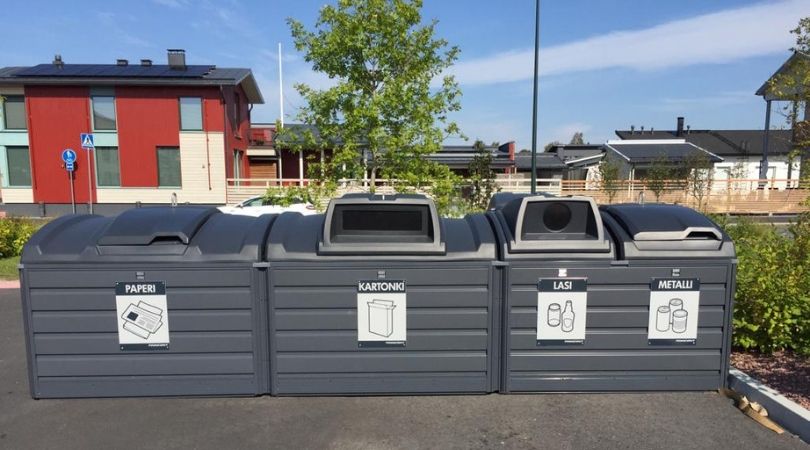One of the benefits of recycling is to take part in the important challenge of resource efficiency and keeping the environment clean. Recycling is transforming waste into resource by following the rules of sorting waste and bringing sorted materials to the collection points for further processing. Sorted valuable materials are returned to the multi-cycle model of circular economy, where the recycled material is used for making new products.
Starting to recycle is a matter of education, attitude and habit. It is important to search for as much information as possible about recycling before starting to make changes, as we want to avoid making mistakes. It is also good to clarify where different waste types are brought after having them sorted out, and what happens to them in the next steps of the process.
In many European countries, especially in the Nordics and Germany, the environmental education is started early. Sorting and recycling are part of children’s curriculum in daycare and at school. Raising the awareness about waste management practices in an early stage is crucial factor when affecting to children’s attitudes. The principles of waste sorting is taught through videos, real life examples and games, not only in theory.
In this blog text I write about recycling in Finland and France at higher level. As the subject belongs to one of my favorites, I will go more into details in my upcoming blog texts, so stay tuned!
What kind of household waste can I recycle?

What facilitates the recycling process is the possibilities for sorting waste at the same pace as we produce it. For this you need enough space for different bins in your kitchen or storage space. This can be a huge challenge in small apartments. However, many innovative solutions have been created to win this challenge even in the smallest apartments. A multi-compartment waste bin is a good solution because for sorting properly you need at least four bins. One for biowaste, one for plastic, one for paper and carton and one for glass.
The most common wastes that can be recycled are biowaste, paper, carton, plastic packaging and plastic bottles, glass, glass bottles, electronic devices, dangerous waste (batteries, paint, chemicals), metal and mixed waste. European Union countries are targeting to recycle 65% of municipal waste and 75% of packaging waste by 2030. European Union aims as well to reduce landfill to maximum 10% of municipal waste. This means very high recycling rates from all EU countries to stop valuable materials, such as plastics, paperboard and biowaste ending up to the landfills. For example, Finland’s municipal waste recycling rate was 40% in 2017 and will without any doubt reach the required rate within the next ten years.
- Pure biowaste is compostable. Composted biowaste is suitable for making biogas and biopetrol, energy and heat.
- Paper and carton packaging, on the other hand, ends up being reproduced as paper mass and become recycled packaging materials.
- Dry plastic packaging end up pellets of plastic and go the new recycled plastic process.
- Dangerous waste must be brought to a specific collection points for careful treatment. If items of dangerous waste ends up in the mixed waste it can create serious security risks, such as a fire, in the waste recycling facilities. The dangerous waste items can also release toxic chemicals to the environment.
- Metal waste is mostly melted and the material used for making new products.
- Mixed waste usually ends up being burned as energy and heat.
Unfortunately there is a difference between what can be recycled and what I can recycle considering the available waste collection system. Waste management systems are organised differently in different countries and regions. Comparing the recycling statistics between different countries, for example, is not completely straight forward. The policy making considering recycling is country specific, which creates big discrepancies in recycling activity comparisons.
One for the deposit € return scheme!

Plastic bottles are the most found items in our oceans and seas. Around 8 million tons of plastic bottles are found every day from the deep waters or shores of our oceans. In spite of the ocean cleaning operations we cannot end the waste drifting to the nature. The reasons why plastic bottles end up to the environment are complex. One of the reasons is lack of education or that a proper waste management system is missing.
What if someone told you that you could get refunded whilst recycling plastic bottles? It sounds pretty tempting doesn’t it?
Finland is the first country in the world to have put in place a deposit system for bottles and cans. As early as in 1952 Finnish started to collect glass bottles. This was mostly affected by the popularity of Coca-Cola which was in the beginning bottled only in glass bottles.
How does the deposit return scheme work?
When a consumer buys a canned or bottled beverage, the deposit is included to the price of the product. Consumer returns plastic and glass bottles as well as aluminium cans intact and empty of contents to the closest bottle recycling machine, which are normally located in all supermarkets and liquor stores (Finland has a state owned monopoly called “Alko” in selling alcohol drinks) and receives a deposit from 0,10 to 0,40 cents per a bottle or a can in return.
In Finland an enterprise called Palpa coordinates the deposit system nationally. Some of the plastic bottles are reused, and the others recycled into pellets for making new plastic bottles. Aluminium cans are without exception recycled but even the cans must be returned intact in order to receive the deposit.
In 2018, 88% of glass bottles, 90% of plastic bottles and 95% of aluminium cans were returned through the deposit system in Finland. The cycle of a single glass bottle can go up to 30 cycles when its brought back to the brewery where it is washed and reused. Once the glass bottle cannot be reused anymore, it is crushed and melted to produce new glass bottles. Every year 400 million plastic bottles are returned to the recycling machines. The recycled plastic bottles are used for making new bottles, plastic packaging for food industry and also recycled polyester clothes.
The deposit system is very clever, it motivates for recycling and helps keeping our environment clean. A deposit as a motivator is not enough though, it is also a question of habits and attitudes. However, the proximity of recycling machines and collection points is a crucial factor that adds to the motivation while making things easier and less time consuming to the consumers. You can return bottles and cans while making your weekly groceries in a supermarket and get a nice surprise at the checkout with the deposit money.
From other European countries at least Sweden, Norway and Netherlands have adopted the deposit system. In Netherlands the consumers pay more of bottled or canned drinks which encourages them to return the used packaging to the collection points and receive the deposit. More recently in July 2019, Scotland also launched a deposit return scheme. As many as 31 000 plastic bottles will disappear from Scotland’s beaches, streets and green areas every day thanks to the newly adopted deposit system.
Expanding the deposit system to plastic packaging

Recently I heard about a small, 2100 inhabitants city called Soini in Finland where a group of volunteers made a test on expanding the deposit system to plastic food packaging with an aim to increase the recycling willingness of people. The volunteers of the association went to the local supermarkets and glued a sticker on each yogurt jar and meat packaging for the deposit from 2 to 10 cents. Consumer who bought the yogurt jar had to pay 10 cents extra at the checkout but was returned the money if he or she returned the yogurt can intact and clean to the collection point. With this test it was demonstrated that even a small deposit increased the willingness for recycling plastics. I find this initiative very intelligent! Too often the minced meat packaging ends up to the mixed waste bin because the consumer doesn’t get the point of recycling it and the valuable material never returns back to the circularity.
I find the deposit system one of the best available solutions for controlling the plastic waste problem. It is also quite easy to put in place in larger scale. However, the fundamental solution would be to ban and regulate single use plastics production. After all, the deposit system manages to affect to the consumer habits and attitudes by giving a carrot, not a stick.
Recycling in Parisian style

I moved to Paris six years ago. Ever since I have not seen much progress in the recycling facilities of the France’s capital. I live currently in a Haussmannien style building in a 2 room apartment in the southern Paris. Each building has a common space for waste containers. It is usually located in the inner court, patio or under ground. In my building we have a white container for glass bottles and jars, yellow container for paper, carton, plastic packaging, plastic bottles, metal and aluminium and a green container for “the rest”. I have never really understood why the yellow container is meant to take a mix of wood based, metal and plastic waste in the same container? At first glance it doesn’t make any sense. And where is a bin for biowaste?
Above all, the garbage trucks comes to empty the containers at least three times a week (probably even more often) in my quarter. Every day, 3000 tons of waste is collected in Paris. That makes more than 1 million tons of waste per year. At the same time it is “normal” when there is only one container of each “waste type” per building where lives about 50 inhabitants. Too often the containers are full or filled in with wrong kind of waste which makes the whole idea or recycling not working at all.
According to the official website of Paris, starting from January 2019, the yellow container can take empty yogurt cans, coffee capsules, egg carton, plastic bags and all food packaging. It doesn’t take toilet paper, Kleenex and paper napkins. These should be put into the green container. The packaging must be empty but there is no obligation to wash and dry them. If green bin waste is mixed with the yellow container waste, the contents will not be recycled. Why? Because the yellow container contents are sorted on a conveyor belt, partly mechanically and partly manually, it could create a stop of the process if unfamiliar items are found on the belt.
The problem of biowaste is obviously the smell. In spite of that I really miss composting my biowaste. In capitals like Paris the possibilities for recycling biowaste are very limited. There is a brown container for biowaste but this container type is not available in every building. Due to the strong odour and easily opening containers, the biowaste attracts rats. That is possibly the biggest reason why biowaste compostes cannot be placed to the buildings garbage bin space. Thus the biowaste goes to the green container packed inside a normal plastic bag.
There is a need for an innovative solution of a biowaste container which would have a small hatch where biowaste in biodegradable bags could be dropped. The compact hatch would take care of that no excess odour is released outside the container.
Recycling other items than household waste
In Paris, small electronic devices are accepted to be returned in supermarkets, telecommunication shops and electronic devices shops. It is easy to find a collection point close to you. Since 2019 the city has organised occasional collection days for working or inoperative electronic devices on Saturdays in different quarters. For big electronic devices the Parisians must book a pick-up date and time on a specific website and attach a reference number on the device, for example, on an inoperative washing machine and place it to the sidewalk.
To find a collection point for old clothes and shoes, that is a whole another story. It is a way more easier to donate them or to sell them through a variety of mobile applications than look for a collection point in the city center. What makes the recycling more challenging for people is that many people doesn’t have a car in Paris so the proximity of collection points is very important. There remains progress to be done in this area.
Without exception, in France the most recycled waste is glass. Every Sunday morning I hear the happy crushing noise from the glass container placed in the inner court where someone is cleaning up the empty wine bottles after a Saturday night dinner party. In contrast to Finland, in France, glass bottles are not reused but crushed and melted for producing new bottles.
The official website of Paris, to what I referred earlier, is unfortunately only in French language. Because Paris is full of foreigners, at least an English translation of the site would be very useful. What I have also wondered since recycling systems are country specific and people are more and more mobile, moving from one place to the other, when arriving to a new city, the city could welcome the new resident with an info package (in digital format of course!) about the quarter waste management system and explaining the recycling principles. This is extremely important in order to reduce common mistakes and avoid misunderstandings.
According to Zero Waste France, France still leaves behind in recycling the municipality waste but is recycling today approximately 25% of all the produced waste.
Even more important than recycling is consuming less
Recycling might sound like a solution for waste problems but actually the recycling process itself consumes resources and energy. Nevertheless, it doesn’t mean that recycling is bad. The real answer to the waste problem is consuming less. Not producing waste is the best solution for the environment.
It seems like recycling is more or less country specific and more importantly, area specific. How recycling of household waste is organised in your municipality or city? What kind of collection points do you have for recycled materials? Where these collection points are situated? And how easy or difficult do you find recycling? For the last but not least – have you made any conscious decisions to simply start consuming less?


Well thought,written and informative blog.Would like to connect directly for discussions on waste management and PET plastic bottles in developing countries in Africa.That includes converting PET recycled material into different sorts of Textile.Our company is based in The Republic of South Africa.